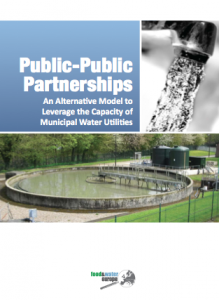DOWNLOAD PDF
Clean drinking water and wastewater treatment are basic services that societies and governments provide. Water is a necessity for life, and safe water and sanitation are crucial for public health. In July 2010, the United Nations declared access to clean water and sanitation to be a human right. But recognizing the human right to water does not explain how to deliver this right to households. Even with this commitment to enhance water delivery and safety, an estimated 884 million people worldwide lack access to safe water, and 2.6 billion lack access to improved sanitation. Meeting this need requires significant investments in infrastructure and expertise. In the last 20 years, major multinational efforts have relied on private sector strategies in both developed and developing countries to provide water. These approaches have included encouraging public- private partnerships (PPPs) between public water utilities and private water companies.
Proponents of privatization promised increased investment and efficiency, but privatization has failed to meet these expectations. Instead, it often has led to deteriorating infrastructure, service disruptions and higher prices for poorer service.
A different model, called public-public partner- ships (PUPs), can be a more effective method for providing services. In contrast to privatization, which puts public needs into the hands of profit- seeking corporations, PUPs bring together public officials, workers and communities to provide better service for all users more efficiently.PUPs allow two or more public water utilities or non-governmental organizations to join forces and leverage their shared capacities. PUPs allow multiple public utilities to pool resources, buying power and technical expertise. The benefits of scale and shared resources can deliver higher public efficiencies and lower costs.
These public partnerships, whether domestic or international, improve and promote public delivery of water through sharing best practices. The partnerships can take many forms and may include networks of public water operators in different areas or non-governmental organiza- tions. As a public collaboration, no PUP partner can generate a profit through the partnership. In short, PUPs provide the collaborative advantages of private partnerships without the profit-extracting focus of private operators, and they promote the public interest mission of equitably delivering water services.
Although PUPs can be used for many public func- tions, including roads and electricity, they have particular applicability to water. Access to safe drinking water varies widely across the globe. The United Nations Millennium Declaration aimed to “halve the proportion of people who are unable to reach or to afford safe drinking water.” To meet that ambitious goal, more than a billion people will need to gain access to safe water and sanita- tion by 2015.
This tremendous undertaking will require both international cooperation and atten- tion to local needs. Public-public partnerships are uniquely suited to this task. The reason that PUPs work so well is that they retain local, public control of existing water systems. Public utilities are responsible for most water and wastewater services worldwide. In 2010, only about 12 percent of the world’s population had water or sewer service that was priva- tized in some way. The nature of water service as a public good and natural monopoly favors the public administration of water systems.



